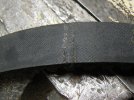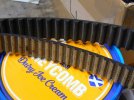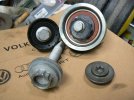Fuchs I think, used to the oil that most VAG DIYers aimed for once out of warranty, the tale was that VAG used that at initial fill at their factories, and VAG had a sort of deal with Castrol for most brands, except SEAT who pushed Repsol.
I started using Quantum Gold, then when it vanished and became Platinum, I moved to Fuchs - then when I got my Audi S4 in 2013, I moved to Mobil 1 ESP 5W-30.
LSPI, looking around the internet, for me at least does always seem to mean ending up on USA sites for Mobil 1 or some other brand, but always its USA area websites.
Mobil 1 European website does not mention any of the "names" that Mobil 1 USA market in their home market for addressing this
problem, so is this, in reality, mainly an issue for hot areas that sell low grade/RON petrol, and maybe not (yet) seen as an issue for Northern European markets where cars use higher grade/RON petrol?
One thing that I want to do is to check the ph value of the G13 in my older daughter's May 2019 Leon Cupra, mainly because I've noticed at service time this year, that the ph value of the G12+ G12++ in my Feb 2011 Audi S4 is still near enough the same as it has always been, but my wife's August 2015 VW Polo 1.2TSI's G13 has moved a lot closer towards the "acid" region - which is maybe to be expected and the very reason that VAG started adding the pouches of Silcate crystals to keep that version of coolant G13 in good condition wrt to it ability to resist corrosion on metals in the system. I'm very near the point of changing the G12+/G12++ in that Audi S4 to G12EVO, I have bought the coolant, made up a "coolant level riser" - to artificially lift the level of the coolant so that bleeding becomes easier as that can be an issue with the Audi S4 etc as the heater pipes are at the normal coolant level of below it! Vacuum Coolant Refill Kit bought, a couple of Supercharger Charge Cooler plastic vent screws bought - just in case and a 10 litre clean plastic container as the G12EVO comes premixed in litre containers! It is also available to 50/60litre drums - but that is a bit much for my current use!
Anyway, yes you did mention coming across the term LSPI some time ago, and probably it was that that caused me to search today for available to us in UK, suitable engine oils for VW Group engines.
I hope your belt change went well, a friend of my wife's husband has a May 2011 Porsche Cayanne 3.0D and it has been in a garage in Pitt Street Leith since 2nd August for its service and MOT - and it is still there with reasons why they can't "calibrate" the electric handbrake system - oh dear! The owner thinks that they are a good bunch of lads and always takes that car there and it has always failed its MOTs for electric handbrake issues and a few other things every or every other year, but up to now he has been happy.





